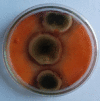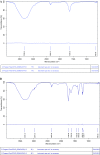Biocatalytic activity of Aspergillus niger xylanase in paper pulp biobleaching
- PMID: 28330237
- PMCID: PMC4980834
- DOI: 10.1007/s13205-016-0480-0
Biocatalytic activity of Aspergillus niger xylanase in paper pulp biobleaching
Abstract
Xylanase is a hemicellulase enzyme that catalyses the hydrolysis of xylan to xylose which is widely used in processing of feed, pulp and paper. It is produced by many microorganisms especially filamentous fungi like Trichoderma and Aspergillus. A potential xylanolytic fungal isolate Aspergillus niger was isolated from forest soils of Tirumala, AP, India, and its crude enzyme was checked for its potential in paper bleaching. Under submerged fermentation, production of xylanase, cellulase, biomass, total protein and sugar released were analysed after 7 days of incubation at room temperature. Maximum enzyme activity was recorded on the fifth day of incubation, biomass after the seventh day, total protein and sugar released on the sixth day of incubation. Enzyme pretreatment of paper reduced 3.5 points in kappa number, 3.1 points increase in brightness and removal of chromophores and hydrophobic compounds. The FTIR and SEM analysis of enzyme-treated sample had shown modification in surface morphology and functional groups. These results clearly demonstrated that the xylanase produced by A. niger was effective as a pulp biobleaching agent which can be used on an industrial scale.
Keywords: Biobleaching; Effluent characteristics; FTIR; SEM; Xylanase.
Conflict of interest statement
Authors have no conflict of interest.
Figures
Similar articles
-
Biobleaching of paper pulp with xylanase produced by Trichoderma asperellum.3 Biotech. 2017 Aug;7(4):266. doi: 10.1007/s13205-017-0898-z. Epub 2017 Jul 28. 3 Biotech. 2017. PMID: 28794921 Free PMC article.
-
Bioprocess and biotecnology: effect of xylanase from Aspergillus niger and Aspergillus flavus on pulp biobleaching and enzyme production using agroindustrial residues as substract.Springerplus. 2013 Aug 13;2:380. doi: 10.1186/2193-1801-2-380. eCollection 2013. Springerplus. 2013. PMID: 24010038 Free PMC article.
-
Biobleaching application of cellulase poor and alkali stable xylanase from Bacillus pumilus SV-85S.3 Biotech. 2013 Aug;3(4):277-285. doi: 10.1007/s13205-012-0096-y. Epub 2012 Oct 10. 3 Biotech. 2013. PMID: 28324585 Free PMC article.
-
Cellulase and xylanase synergism in industrial biotechnology.Appl Microbiol Biotechnol. 2019 Nov;103(21-22):8711-8724. doi: 10.1007/s00253-019-10146-0. Epub 2019 Oct 18. Appl Microbiol Biotechnol. 2019. PMID: 31628521 Review.
-
Engineering Thermostable Microbial Xylanases Toward its Industrial Applications.Mol Biotechnol. 2018 Mar;60(3):226-235. doi: 10.1007/s12033-018-0059-6. Mol Biotechnol. 2018. PMID: 29380253 Review.
Cited by
-
Rice straw fermentation by Schizophyllum commune ARC-11 to produce high level of xylanase for its application in pre-bleaching.J Genet Eng Biotechnol. 2018 Dec;16(2):693-701. doi: 10.1016/j.jgeb.2018.02.006. Epub 2018 Feb 23. J Genet Eng Biotechnol. 2018. PMID: 30733790 Free PMC article.
-
CAZyme prediction in ascomycetous yeast genomes guides discovery of novel xylanolytic species with diverse capacities for hemicellulose hydrolysis.Biotechnol Biofuels. 2021 Jul 2;14(1):150. doi: 10.1186/s13068-021-01995-x. Biotechnol Biofuels. 2021. PMID: 34215291 Free PMC article.
-
Enhanced production of xylanase by Fusarium sp. BVKT R2 and evaluation of its biomass saccharification efficiency.3 Biotech. 2017 Oct;7(5):351. doi: 10.1007/s13205-017-0977-1. Epub 2017 Sep 26. 3 Biotech. 2017. PMID: 28955648 Free PMC article.
-
Biobleaching of paper pulp with xylanase produced by Trichoderma asperellum.3 Biotech. 2017 Aug;7(4):266. doi: 10.1007/s13205-017-0898-z. Epub 2017 Jul 28. 3 Biotech. 2017. PMID: 28794921 Free PMC article.
-
Co-elicitation of lignocelluloytic enzymatic activities and metabolites production in an Aspergillus-Streptomyces co-culture during lignocellulose fractionation.Curr Res Microb Sci. 2022 Feb 11;3:100108. doi: 10.1016/j.crmicr.2022.100108. eCollection 2022. Curr Res Microb Sci. 2022. PMID: 35243445 Free PMC article.
References
-
- Bailey MJ, Biely P, Poutanen K. Interlaboratory testing of methods for assay of xylanase activity. J Biotechnol. 1992;23:257–270. doi: 10.1016/0168-1656(92)90074-J. - DOI
-
- Betini JHA, Michelin M, Peixoto-Nogueira SC, Jorge JA, Terenzi HF, et al. Xylanases from Aspergillus niger, Aspergillus niveus and Aspergillus ochraceus produced under solid-state fermentation and their application in cellulose pulp bleaching. Bioprocess Biosyst Eng. 2009;32:819–824. doi: 10.1007/s00449-009-0308-y. - DOI - PubMed
-
- Bissoon S, Christov L, Singh S. Bleach boosting effects of purified xylanase from Thermomyces lanuginosus SSBP on bagasse pulp. Process Biochem. 2002;37:567. doi: 10.1016/S0032-9592(01)00259-X. - DOI
LinkOut - more resources
Full Text Sources
Other Literature Sources





